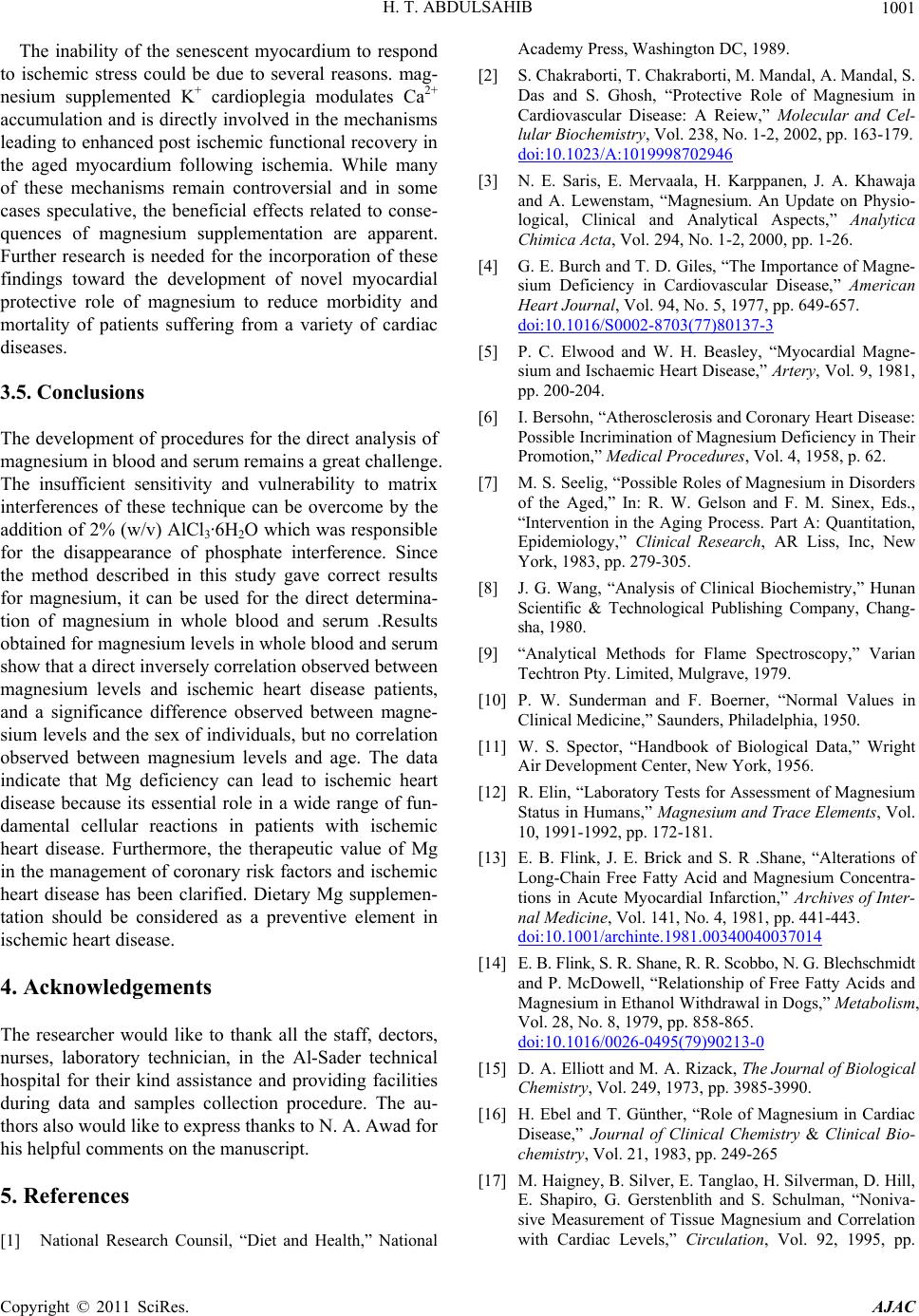
H. T. ABDULSAHIB1001
The inability of the senescent myocardium to respond
to ischemic stress could be due to several reasons. mag-
nesium supplemented K+ cardioplegia modulates Ca2+
accumulation and is directly involved in the mechanisms
leading to enhanced post ischemic functional recovery in
the aged myocardium following ischemia. While many
of these mechanisms remain controversial and in some
cases speculative, the beneficial effects related to conse-
quences of magnesium supplementation are apparent.
Further research is needed for the incorporation of these
findings toward the development of novel myocardial
protective role of magnesium to reduce morbidity and
mortality of patients suffering from a variety of cardiac
diseases.
3.5. Conclusions
The development of procedures for the direct analysis of
magnesium in blood and serum remains a great challenge.
The insufficient sensitivity and vulnerability to matrix
interferences of these technique can be overcome by the
addition of 2% (w/v) AlCl3·6H2O which was responsible
for the disappearance of phosphate interference. Since
the method described in this study gave correct results
for magnesium, it can be used for the direct determina-
tion of magnesium in whole blood and serum .Results
obtained for magnesium levels in whole blood and serum
show that a direct inversely correlation observed between
magnesium levels and ischemic heart disease patients,
and a significance difference observed between magne-
sium levels and the sex of individuals, but no correlation
observed between magnesium levels and age. The data
indicate that Mg deficiency can lead to ischemic heart
disease because its essential role in a wide range of fun-
damental cellular reactions in patients with ischemic
heart disease. Furthermore, the therapeutic value of Mg
in the management of coronary risk factors and ischemic
heart disease has been clarified. Dietary Mg supplemen-
tation should be considered as a preventive element in
ischemic heart disease.
4. Acknowledgements
The researcher would like to thank all the staff, dectors,
nurses, laboratory technician, in the Al-Sader technical
hospital for their kind assistance and providing facilities
during data and samples collection procedure. The au-
thors also would like to express thanks to N. A. Awad for
his helpful comments on the manuscript.
5. References
[1] National Research Counsil, “Diet and Health,” National
Academy Press, Washington DC, 1989.
[2] S. Chakraborti, T. Chakraborti, M. Mandal, A. Mandal, S.
Das and S. Ghosh, “Protective Role of Magnesium in
Cardiovascular Disease: A Reiew,” Molecular and Cel-
lular Biochemistry, Vol. 238, No. 1-2, 2002, pp. 163-179.
doi:10.1023/A:1019998702946
[3] N. E. Saris, E. Mervaala, H. Karppanen, J. A. Khawaja
and A. Lewenstam, “Magnesium. An Update on Physio-
logical, Clinical and Analytical Aspects,” Analytica
Chimica Acta, Vol. 294, No. 1-2, 2000, pp. 1-26.
[4] G. E. Burch and T. D. Giles, “The Importance of Magne-
sium Deficiency in Cardiovascular Disease,” American
Heart Journal, Vol. 94, No. 5, 1977, pp. 649-657.
doi:10.1016/S0002-8703(77)80137-3
[5] P. C. Elwood and W. H. Beasley, “Myocardial Magne-
sium and Ischaemic Heart Disease,” Artery, Vol. 9, 1981,
pp. 200-204.
[6] I. Bersohn, “Atherosclerosis and Coronary Heart Disease:
Possible Incrimination of Magnesium Deficiency in Their
Promotion,” Medical Procedures, Vol. 4, 1958, p. 62.
[7] M. S. Seelig, “Possible Roles of Magnesium in Disorders
of the Aged,” In: R. W. Gelson and F. M. Sinex, Eds.,
“Intervention in the Aging Process. Part A: Quantitation,
Epidemiology,” Clinical Research, AR Liss, Inc, New
York, 1983, pp. 279-305.
[8] J. G. Wang, “Analysis of Clinical Biochemistry,” Hunan
Scientific & Technological Publishing Company, Chang-
sha, 1980.
[9] “Analytical Methods for Flame Spectroscopy,” Varian
Techtron Pty. Limited, Mulgrave, 1979.
[10] P. W. Sunderman and F. Boerner, “Normal Values in
Clinical Medicine,” Saunders, Philadelphia, 1950.
[11] W. S. Spector, “Handbook of Biological Data,” Wright
Air Development Center, New York, 1956.
[12] R. Elin, “Laboratory Tests for Assessment of Magnesium
Status in Humans,” Magnesium and Trace Elements, Vol.
10, 1991-1992, pp. 172-181.
[13] E. B. Flink, J. E. Brick and S. R .Shane, “Alterations of
Long-Chain Free Fatty Acid and Magnesium Concentra-
tions in Acute Myocardial Infarction,” Archives of Inter-
nal Medicine, Vol. 141, No. 4, 1981, pp. 441-443.
doi:10.1001/archinte.1981.00340040037014
[14] E. B. Flink, S. R. Shane, R. R. Scobbo, N. G. Blechschmidt
and P. McDowell, “Relationship of Free Fatty Acids and
Magnesium in Ethanol Withdrawal in Dogs,” Metabolism,
Vol. 28, No. 8, 1979, pp. 858-865.
doi:10.1016/0026-0495(79)90213-0
[15] D. A. Elliott and M. A. Rizack, The Journal of Biological
Chemistry, Vol. 249, 1973, pp. 3985-3990.
[16] H. Ebel and T. Günther, “Role of Magnesium in Cardiac
Disease,” Journal of Clinical Chemistry & Clinical Bio-
chemistry, Vol. 21, 1983, pp. 249-265
[17] M. Haigney, B. Silver, E. Tanglao, H. Silverman, D. Hill,
E. Shapiro, G. Gerstenblith and S. Schulman, “Noniva-
sive Measurement of Tissue Magnesium and Correlation
with Cardiac Levels,” Circulation, Vol. 92, 1995, pp.
Copyright © 2011 SciRes. AJAC